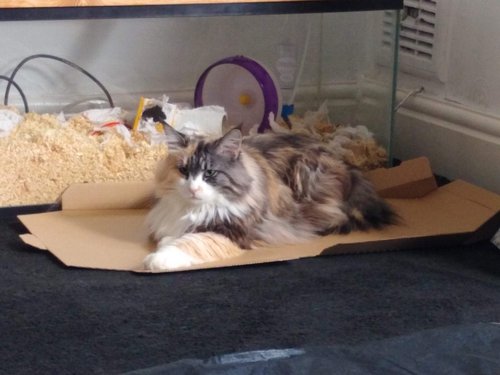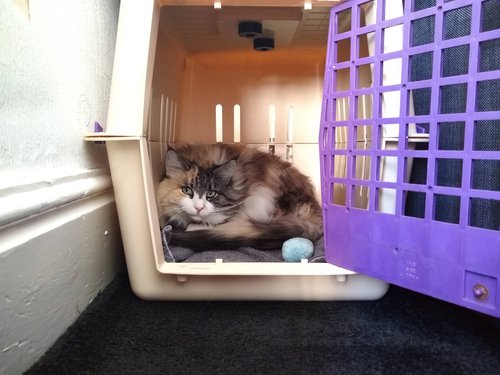Settling in a New Cat
Settling in a new cat can take some time. It all depends on the nature of the cat, where it has come from, what it is used to, and what the new home is like.

I didn't think I would be settling in a new cat. Unfortunately our much loved cat Ginger, died early in May. We were all so sad. It left such a hole in our hearts. As mentioned previously, Ginger was a large part of our life; the first thing I looked for in the morning to the last thing I saw at night.
After a week of no Ginger, we all felt bereft. I thought I'll email the rescue which is part of the Norwegian Forest Cat Club. Last time it took months to find a cat that needed a home so I expected it to take a while. However, I had an email back saying that they had a cat that was suitable for us. I rang the next day, had a chat with the lady and arranged to pick her up.
So on the 19th of May, we drove to pick her up! (Even with this state of lockdown, we were allowed to collect a cat but we felt naughty as we hadn't driven outside of the very local area for nearly 3 months.)
We met the lady with the cat, socially distancing of course. It was a very strange situation but nothing is normal these days. We'd had quite a chat on the phone and WhatsApp so we only had a brief chat at the handover.
I'm really hoping that our new puss settles in quickly. We are doing the things listed below!
Settling in a New Cat
Patience is the key! This is easier said than done but it is worth it in the long run. Each cat is different so their needs and what works will vary.
The time taken for the cat to settle in will depend on it's past, personality and the new situation.
Before you bring the cat home, get everything ready for it. This means that the cat will find its things in the same place and will be able to settle in without the owner running round, moving furniture etc.
Specific Room
Set up a room where the cat will first get used to. This should have food, water, litter tray, toys and a bed. Ideally, this room should be quiet, with hiding places but where people are.
We settled our cat in the kitchen. It is a really big room where it is less manic compared to the rest of the house.
Keep the cat shut in that room overnight for the first couple of days. The night time gives the pet a chance to explore the room and feel comfortable before exploring the rest of the house.
Gradually let the cat explore other rooms.
Bring Items from their Previous Home
They will wonder what is going on so bring items that smell of their previous home.
Our new cat came with toys, blanket and a travel case. We put these in her room so that she would feel safe. As the first week went on, she would sit on top of her travel cage rather than in it.
Find out what litter and food they are used to. Moving to a new home is a big thing so it is best to keep as much the same as possible including feeding routine.
Create Safe Places

Create safe places in different rooms so the cat can hide if it feels the need. Ideally, they should be out of the way and near a wall.
We put a bed in the kitchen corner, a travel box in a different part of the kitchen, a couple of boxes in the living room, a cat tree in the hall and boxes in the bedroom. She found her own safe places as well so in a few weeks I will be able to put away the travel case.
The picture to the left is our new cat in her travel cage in the living room. I've not shut the door and she can go in and out as she pleases. It is at the side of the sofa out of the way. She also liked to lie behind the sofa for a while.
Talk to the Cat
Talk to the cat so it can get used to your voice and presence. Use their name so they get used to it. I do this all the time - our new cat is less scared of me and my daughter compared to my husband and son.
Ok so my ramblings are 'who's beautiful' and 'do you want to play' but eventually I know she'll love it. If it is dinner time I shout 'din dins' and rattle the bowl so she knows. At first I then had to go and show her the food but she soon caught on and appears.
Routine
It is important to keep to a routine so that the cat will know what life is like in your house. Most cats will make their own routine and feeding time may be the only thing the owner controls. Having our cat a week, she now appears at 7pm for her tea.
Obviously, still being in lockdown, the routine is different to normal but we make the effort to get up at the same time each day to feed the cat.
Be Gentle
Loud noises and fast running people are scary for the new cat as they don't know what is happening. It will take a while for it to get used to people and their habits.
Personal Space
Let the cat have personal space to explore its new surroundings. Let the cat come to you and don't chase, it as it will get scared.
Watch and React to Body Language
This is really important but a massive subject in itself. I would recommend researching further on this. You can tell a lot about how a cat is feeling from their body language - tail, ears and body position as well as what their eyes are doing. Purina has a really good article with pictures depicting different cats' behaviour and feelings.
Behaviour may change overtime so watch to see if your behaviour needs to change in response. For example, they may not like a certain noise.
Please note that behaviour signs may vary depending on the cat. Once you get to know it better you will understand your cat more and instinctively know what it is feeling.
Cuddles, Affection and Grooming
Some cats will like being stroked where as some will want their own space. Again, you will have to read your cats behaviour to see what is best.
If your cat is approachable, likes being stroked grooming will help build a bond.
Playing
Playing is a great tool to help the build the bond between cat and owner. There are so many toys available! Again, cats will have a preference but at the end of the day, anything that moves or wiggles is a winner.
Sometimes they are distracted when their predator behaviour kicks in and they relax into their environment without realising.
Supplements
As mentioned in a previous article about Fireworks, there are medical supplements that can be purchased to help with cat anxiety. There are a range of tablets, capsules and chews available to purchase without a prescription.
Happy Hormones
There are increasing brands of 'happy hormones' on the market now but I use Feliway as have had previous success with it. Feliway replicates the pheremones that the cat would produce if it was happy and therefore creates a calming environment reducing its anxiety. This is either a plug in diffuser for a house, or a spray for localised areas or travel cages.
Vet Intervention
If the cat 'doesn't seem right' or doesn't use the litter tray or eat, please contact your vet for advice. Vets may be able to prescribe medication for the short term as well as offering advice. At the moment in lockdown, telephone consultations may be the only option.
Conclusion
The Cats Protection League recommend keeping the cat indoors for 3 to 4 weeks before letting them go outside. I would suggest longer is better as you want to make sure they come back! This means that the bond will be there and puss will want to come back. If you get a rescue cat, don't forget to update the microchip details as soon as possible.
It is hard to write a definitive article on what to do as it does vary with each cat. In fact some will love humans and what ever they do, whereas others will hate interaction. It is a case of trial and error. Most cats will settle in quickly and become part of the family. You won't even remember that settling in a new cat was an issue.
We've only had our cat a couple of weeks and we have got so many happy memories already. We all love her and she has made us feel happy. She really is so nervous still but I am hoping it improves and she settles in soon.
If you would like to sign up for my newsletter, please sign up here.
Newsletters are sent monthly at most. No junk mail or spam sent!